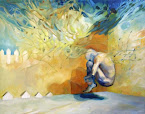The beginning sequence introduced Don Corleone's study and Connie's wedding. The events of the wedding and the events within the study are happening simultaneously, even though they contain contrasting imagery.
In the study, Vito is the character given the most presence in the scene, and not just because he's being played by Marlon Brando, the "star" of the film. He's the head of the Corleone family; the Godfather, and he is being requested to do things, per Sicilian tradition. There were many props in that set, two of which were very prominent. There was the cat which Vito was holding during his first medium shot. This cat contrasted the dark setting, both in nature and in color, and it was a symbol that though Vito is a foreboding figure he is a caring family man. The other was Vito's desk. This prop may have had even more of presence than Vito. That desk represented power, and it was a powerful symbol.
The best interaction of settings in the film was probably the back and forth viewing of the study and Connie's wedding. These interactions, as I mentioned before, contrast in elements but communicate the same things; the importance of tradition and family.
The overall setting for the movie was 1940's New York. The sets, therefore, reflect this time period. It's post-WWII America, and though most citizens are breathing a sigh of relief about peace time, the Corleones end up waging a mob war. Some scenic connotations therefore reflect and underworld war during civilian peace time.
One aspect of the set(s) which contributed to the understanding of this would be concealed pistols.
There was one scene in which the blocking was important and highly explanatory of the characters. It is the scene in which Clemenza, Tom Hagen, Michael, and Sonny are discussing the problem with Sollozzo and McCluskey. In one particular shot, Clemenza is not in view, but Tom is sitting and leaning back into a chair, because he is the one who always wants to talk things out. Sonny is standing, hungry for action (which usually means blood). Michael is sitting between them, and he is sitting in an unsettled way, communicating his ambivalence and balance between the two. In my opinion, it's as early as that scene when the realization that he would be the next godfather begins to set in.
Costumes play a monumental part in this film, partly because of the time period, and partly because of the occupation of most of the characters. There are a lot of suits. One example is that Michael makes a suit-wearing transition throughout the film. When we are first introduced to Michael, he's wearing his Army uniform. He's a war-hero, proud to be American. For a bit, he's wearing nice but casual clothes. He's a civilian. In Sicily he's wearing simple clothes. He's finding himself. When he's courting Appolonia, he wears modest but gentlemanly clothes. He's a nice, Catholic, Sicilian boyfriend. When he's back in America, his suits are very nice. He's the semi-head of the Corleone family. Toward the very end of the film, he's wearing fancy, expensive-looking suits. He is the Godfather.
Through costuming creating scenic realism, a stark contrast is drawn between Kay and Appolonia. Kay wears nice American fashion. She is a sort of simple and plain character. Appolonia is strikingly beautiful, and her subtle dresses accentuate her beauty.
Make-up is also integral. At one point, both Michael and Connie have badly battered faces and the make-up portrays that. Vito's aging is portrayed through make-up, and very well, too, considering that Marlon Brando was at least fifteen years younger than his character.
The mis-en-scene is this film definitely fits best with a naturalistic tradition. Besides the violence, there were really no grand, sweeping gestures indicating what the story was, nor were there any long monologues. Everything was subtle.
Sunday, October 4, 2009
Subscribe to:
Post Comments (Atom)

No comments:
Post a Comment